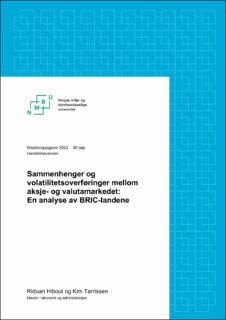| dc.contributor.advisor | Guttormsen, Atle | |
| dc.contributor.advisor | Gjølberg, Ole | |
| dc.contributor.author | Hibout, Riduan | |
| dc.contributor.author | Tørrissen, Kim | |
| dc.date.accessioned | 2021-10-26T07:46:14Z | |
| dc.date.available | 2021-10-26T07:46:14Z | |
| dc.date.issued | 2021 | |
| dc.identifier.uri | https://hdl.handle.net/11250/2825543 | |
| dc.description.abstract | Formålet med denne masteroppgaven er å se på forholdet mellom aksje- og valutamarkedet for Brasil, Russland, India og Kina (BRIC). Vi har innhentet data fra aksjeindeksene Bovespa (Brasil), MOEX (Russland), NIFTY50 (India) og SSE Composite (Kina). For valutakursene har vi innhentet data for hvert lands lokale valuta målt mot amerikanske dollar. All data er ukentlig for perioden januar 2006 til og med desember 2020. En EGARCH-modell brukes for å analysere forholdet i avkastning og volatilitet for hvert land. Vi finner indikasjoner på volatilitetsoverføringer fra valutamarkedet til aksjemarkedet for alle land. Denne volatilitetsoverføringen er asymmetrisk, som betyr at negative sjokk påvirker volatiliteten i større grad enn gode sjokk. Motsatt vei finner vi signifikante volatilitetsoverføringer fra aksjeavkastningen til valutaavkastningen for tre av fire land, med India som unntaket. Volatilitetsoverføringen er asymmetrisk for Brasil, Russland og India, for Kina ble det ikke funnet støtte.
Resultatene av denne studien kan være av interesse for individuelle investorer, internasjonale selskaper, hedgefond og andre som diversifiserer porteføljene gjennom internasjonale investeringer. For blant annet multinasjonale selskaper vil resultatet av denne studien hjelpe med å konstruere effektive hedgingstrategier mot valutarisiko. | en_US |
| dc.description.abstract | The purpose of this master thesis is to analyze the relationship between the stock market and currency market for Brazil, Russia, India and China (BRIC). We have used the stock indices Bovespa (Brazil), MOEX (Russia), NIFTY50 (India) and SSE Composite (China). For the currency we have collected local currency against the american dollar. We have used weekly data for the period from january 2006 to december 2020. To examine the relationship between the stock market and currency market returns and the volatility we have used the EGARCH model. We find significant volatility spillover from the currency market to the stock market for all four countries. This spillover effect is asymmetric which indicates that negative shocks create more volatility than positive shocks. Conversely, we find significant volatility spillover from the stock market to the currency market for three out of four countries. For India we find no evidence of volatility spillover. The volatility spillover was found to be asymmetric for Brazil, Russia and India. For China, no evidence for asymmetric volatility was found.
The results of this study may be of interest for individual investors, multinational companies, hedge funds and others who diversify their portfolios through international investments. For multinational companies, among others, the results of this study can help to construct effective hedging strategies against currency risk. | en_US |
| dc.language.iso | nob | en_US |
| dc.publisher | Norwegian University of Life Sciences, Ås | en_US |
| dc.rights | Attribution-NonCommercial-NoDerivatives 4.0 Internasjonal | * |
| dc.rights.uri | http://creativecommons.org/licenses/by-nc-nd/4.0/deed.no | * |
| dc.title | Sammenhenger og volatilitetsoverføringer mellom aksje- og valutamarkedet : en analyse av BRIC-landene | en_US |
| dc.type | Master thesis | en_US |
| dc.description.localcode | M-ØA | en_US |

